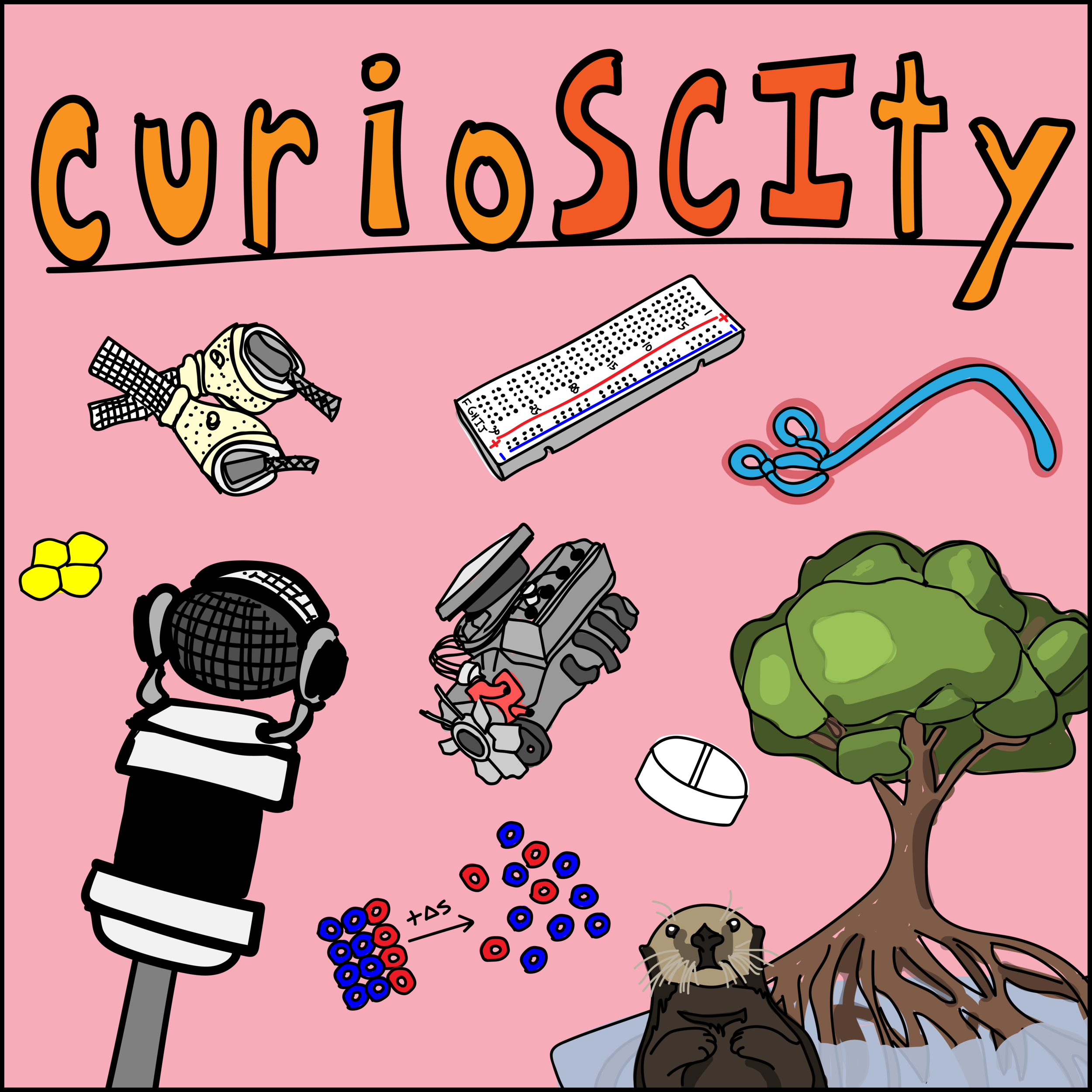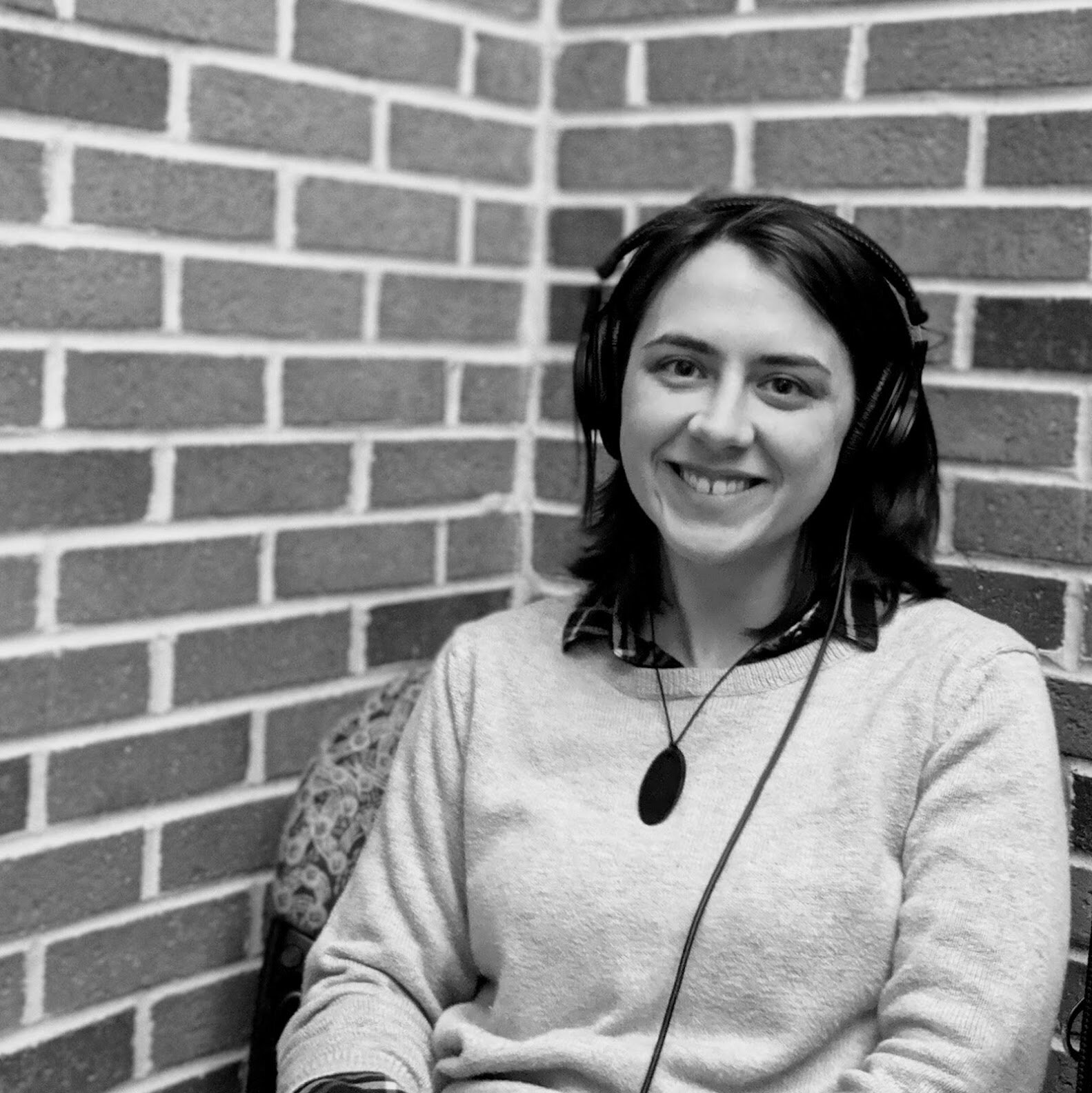Click on the guest’s image to examine the episode’s citations. Click here to find Curioscity on a variety of different services, including Apple Podcasts, Google Podcasts, Stitcher, and more.
2019 - Season 1
Brian Conlon, Ph. D., is an Assistant Professor at The University of North Carolina at Chapel Hill.
What are the benefits to antibiotics? What are the consequences?
Adele Musicant is a Ph. D. candidate in Genetics at The University of North Carolina at Chapel Hill.
Today we’ll discuss dry ice; bio-luminescence; women’s representation in film; and science communication.
Allison Williams and TJ Russell are Ph. D. candidates in Biochemistry, Microbiology, and Molecular Biology at The Pennsylvania State University at University Park.
It is common to be exposed to topics involving science in school, but this rarely is made as exciting as watching a sci-fi film.
Nyssa Tucker is an ORISE biological researcher in the Research Triangle Park area.
What are organs? Why do we need them? What is the liver?
Connor Wander is a Ph. D. candidate in Pharmacology at The University of North Carolina at Chapel Hill.
What are pharmaceuticals? What are side-effects?
Shehzad Sheikh, M. D. Ph. D., is a physician and associate professor at The University of North Carolina at Chapel Hill.
What is the digestive tract? What happens when your immune system picks on it unfairly? What is the current course of treatment for these disorders?
Jen Buccholz is a Ph. D. candidate in Psychology and Neuroscience at The University of North Carolina at Chapel Hill.
What is it to be scared? Can we define emotions, and how do emotions like fear tie into our daily life nowadays? How are fear and anxiety related?
Steve Sujansky is a graduate student in Chemistry at The Colorado State University.
How does one do chemical synthesis? What are limitations? What are some examples of scaled chemical reactions?
Zachary Billman is an M. D. Ph. D. student in Microbiology and Immunology at The University of North Carolina at Chapel Hill.
What are the benefits and consequences of non-human primates? What are the ethical dilemmas attached to any model system?
Ananth, Camille, and Cecilia are current or historical members of the Chapel Hill East iGEM team.
Today, we will discuss how a high school in the Chapel Hill area contributes to the scientific field of synthetic biology in a global fashion.
Annie is a current member of the Chapel Hill East iGEM team, while Patty acts as the iGEM advisor.
Science accessibility has gotten better and better over the last few decades, and standardizing the tools to be able to do it has been a huge part.
Philip Hollingsworth is the Institute of the Arts and Humanities Program Administrator at The University of North Carolina at Chapel Hill.
Today we’ll discuss nutrients at the seafloor; gain of function mutations spurred by the atom; the countless combinations of colors in your typical Rubik’s cube.
Dan Mar is the owner of High Tide Permaculture.
Today, we will explore a cousin strategy to typical agriculture: permaculture.
Archer Harmony is an IT application analyst at the County of Humboldt, California. Calvin and Archer became best friends in 3rd grade, 2002.
What is cryptocurrency? Where did the idea begin? Should you buy in?
Kathy Yeager is a high school educator in California. She’s also Calvin’s mother.
What is a chemical reaction? How can it proceed? What is a catalyst?
Bob Yeager is a fine woodworker and luthier in California. He’s also Calvin’s father.
Science is often intrinsically linked to quantification; the ability to report accurate data to peers and colleagues provides the basis for reproducibility.
Fadi Alnaji is a post-doctoral researcher at The University of Illinois at Urbana Champaign.
It can become challenging to explain data when you’re not familiar with the field or it is presented in a confusing way.
Adam Lauring, M. D. Ph. D., is a physician and associate professor at The University of Michigan at Ann Arbor.
What kind of doctorates are there? What are the benefits or consequences of having more than one?
Evan Flynn hasn’t told Calvin exactly… precisely what his current job is, but let’s just call it “being a movie buff". He’s also a Hartwick alumni!
It is common to be exposed to topics involving science in school, but this rarely is made as exciting as watching a sci-fi film.
Jen Heemstra, Ph. D., is an associate professor at Emory University.
How are these degrees dissimilar from a bachelor’s degree? What are some common complaints and issues for graduate students today?
Emery (formerly Grace) Usher is a Ph. D. candidate in Biochemistry, Microbiology, and Molecular Biology at The Pennsylvania State University.
Today, we’ll discuss using human cells as models for research and how those “cells-in-dishes” are different than the cells in our very own bodies.
Molly Rathbun, M.P.S., is a Ph. D. candidate in Biochemistry, Microbiology, and Molecular Biology at The Pennsylvania State University. She’s also a close friend.
Humankind only developed a few hundred thousand years ago and was surrounded by “cousin” hominids from genetic ancestors.
Eric J. Barron, Ph. D., is the President of The Pennsylvania State University.
Today, we’ll discuss a journey from a bachelor degree to being a university president.
Sam Hartmann is a Ph. D. candidate in Biochemistry, Microbiology, and Molecular Biology at The Pennsylvania State University.
What is the chemistry of the firework, and what is the historical basis?
Seria Chatters, Ph. D., is an assistant professor in Education at The Pennsylvania State University at University Park.
Today we’ll discuss ethics in science and the case study of head transplants; and similarities and dissimilarities of diversity and race.
Brian Redder, M.S., is a Ph. D. candidate in Biogeochemistry and Soil Sciences at The Pennsylvania State University. He’s also a Hartwick alumni!
What is the importance of these habitats? What is limestone? How are caves formed?
Pedro Rivera Pomales is a Ph. D. candidate in Chemistry at The Pennsylvania State University.
What are the fundamental components of an atom? What are elements?
Aaron Griffing, M.S., is a Ph. D. candidate in Biology at Marquette University. He’s also a Hartwick alumni!
Who was Charles Darwin? Whose shoulders did he stand on? What is evolution?
Henry Hsiung, M.S., is a Ph. D. candidate in Biochemistry, Microbiology, and Molecular Biology at The Pennsylvania State University. He’s also a close friend.
Today we will discuss the endosymbiotic hypothesis in terms of mitochondria while keeping in mind that the process is equally applicable to chloroplasts.
Divyanshi Srivastava is a Ph. D. candidate in Bioinformatics and Genomics at The Pennsylvania State University.
How do humans use computational resources to analyze data? What is big data and machine learning?
Amber Miller is a Lecturer and Academic Advisor at The Pennsylvania State University at University Park. Heather Giebink is the Director of Graduate Affairs and Assistant Teaching Professor at The Pennsylvania State University at University Park. Tom Henderson is a Senior Account Manager at Carl Zeiss MicroImaging.
To have an effective scientific community, a diverse and skilled group of individuals are required. What are some less stereotypical scientific careers?
Emma Raich is an undergraduate student at The Pennsylvania State University.
Today, we will discuss astronomy, planets and stars, current ways to see these objects, and how round the Earth is.
Neela Yennawar is the Director of Automated Biological Calorimetry and X-ray Crystallography Facility at The Pennsylvania State University at University Park.
What are ways that that scientists can see very small things? How are these techniques different for material science, biology, chemistry, or physics?
Kyla Garten is a Herpetologist and Wildlife Biologist.
Invasive species challenge the natural environment of many places they once did not call home. Why are invasive species dangerous?
Mahtab Peyambari is a Visiting Scholar at The Pennsylvania State University at University Park.
What is a model organism? Why would a researcher use a worm for research? What is the historical basis of C. elegans research?
Gregory Broussard is an Associate Teaching Professor at The Pennsylvania State University at University Park.
Last week we spoke of bacteria, a major contributor to biofilms. What are biofilms and why do microbes make them?
Neeraj Karamchandani is a Ph. D. candidate in Computer Science at The Pennsylvania State University at University Park.
Just what is this domain of life? Why are bacteria important to our global ecosystem? Are they always dangerous?
Averie and Chelsea Elias run the ‘Practice What You Preach’ podcast.
What are lipids, or fats? How does the human body get fats? What are relevant pharmaceuticals related to cholesterol?
Vincent Racaniello is Earth’s Virologist.
What are picornaviruses? Why is there a need for researching viruses like EV-D68 and EV-A71?
Donald Hahn is an Attorney at Law and Mayor of State College.
Who were some of the physicians responsible for reducing mortality of surgery and hospital living? How are things sterilized now?
Rachel Kruger is a water plant bottling technician. She’s also a close friend.
What does the Nobel prize represent? Where are the Prizes origins?
Matt Fares is a Ph. D. candidate in Chemistry at The Pennsylvania State University.
Today, we’ll discuss some of the reasons that DNA is a blueprint and some crazy folktales that have helped explain the birds and the bees.
Dale Ayton and Donna Haines are Educators from the greater Philadelphia Area.
What is DNA and how is it so fundamentally important to how each of us develop? Today, we’ll discuss DNA, the central dogma, and twins.
Susan Russell, Ph. D., is an Associate Professor of Theatre and Penn State Laureate at The Pennsylvania State University at University Park.
Today we’ll discuss individuals who think they’re more capable than they are; how one determines what reputable information is; coffee without a filter.
Tom Nigl is a Ph. D. candidate and 3M Fellow in Chemical Engineering at The Pennsylvania State University at University Park.
Much of humankind has become increasingly more dependent on portable electrical energy. What is a battery?
Morgan Engler is a Student of the College of Osteopathic Medicine at Lake Erie College of Osteopathic Medicine.
Ferns give you an excuse to use words like fiddlehead, pteridology, and give each of us the chance to become a frond friend.
Jerome Mack is an undergraduate student at The Pennsylvania State University.
Today, we will discuss some important concepts about using mice as model organisms. Why would humans use mice as model organisms?
Gavin Hennessy is an undergraduate student at The Pennsylvania State University. His episode was also the pilot for the podcast, making Gavin the first ever guest on the program!
In today’s episode, we will discuss influenza and some subtleties of the flu vaccine. What is the flu? What is the vaccine and who designs it?
Aliza Herman is a primary school teacher in the greater Philadelphia area.
Three years of Nobel prizes were directly related to insulin. Today, we’ll discuss what insulin is and why it’s important.
Andrew Woodman is a post-doctoral researcher at The Pennsylvania State University at University Park.
On this inaugural episode of Curioscity, we delve into a simple question: do scientists always agree?



















































